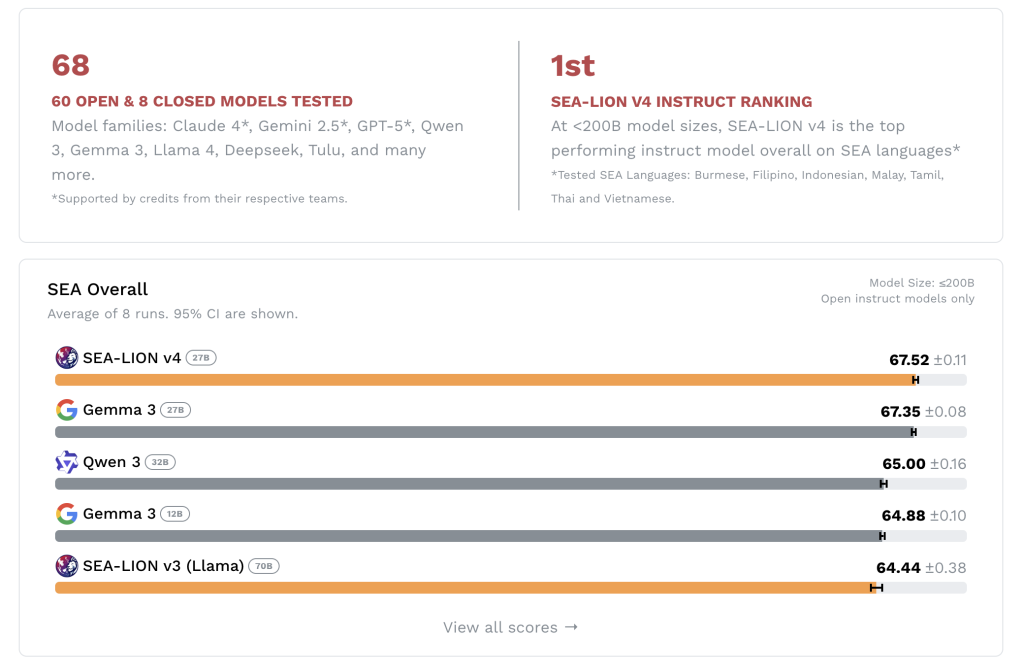AI Singapore (AISG) has released SEA-LION v4, an open-source multimodal language model developed in collaboration with Google and based on the Gemma 3 (27B) architecture. The model is designed to support Southeast Asian languages, including those with limited digital resources, and provides both text and image understanding capabilities. SEA-LION v4 uses a commercially permissive license and is intended for straightforward deployment on standard hardware platforms.


Benchmark Results: “Small” but State-of-the-Art
Performance evaluations on the SEA-HELM benchmark—a rigorous multilingual suite designed specifically to test Southeast Asian (SEA) languages—confirm SEA-LION v4’s capabilities. Across tasks in Burmese, Filipino, Indonesian, Malay, Tamil, Thai, and Vietnamese, v4 achieves a top ranking among models under 200B parameters, and globally places #5 out of 55 models tested.
This result is striking: the model is not only outperforming open-source peers like Llama 3, Qwen 3, and Gemma 3, but also holding its own against proprietary giants with parameter counts several times larger.
- Filipino: 74.53 (v4) vs. 74.09 (Gemma 3-27B)
- Malay: 71.31 (v4) vs. 71.20 (Gemma 3-27B)
- Tamil: 68.47 (v4) vs. 68.45 (Gemma 3-27B)
- Burmese: 57.18 (v4) just behind Gemma 3’s 57.78, outperforming Llama 4 MoE (109B).
In many languages, SEA-LION v4 performs on par with or better than models over 3–10x its size. This balance of efficiency and capability makes it one of the strongest openly available multilingual models for both research and industry use.
What’s New in SEA-LION v4
The fourth-generation model introduces several major technical advancements that make it uniquely suited for both regional and global applications:
1. Open Sourced
Unlike many closed models, SEA-LION v4 is released under the commercially permissive Gemma license, lowering adoption barriers for startups, researchers, and enterprises. Distribution is supported across multiple ecosystems:
- Hugging Face (fine-tuned and base models)
- Google Cloud Vertex AI
- AWS SageMaker
- Kaggle for lightweight experimentation
- NVIDIA NIM and Ollama for edge deployment
This openness ensures SEA-LION v4 can be integrated into workflows across both cloud-scale enterprises and on-device environments.
2. Efficiency and Portability at Scale
Despite its 27B parameters, SEA-LION v4 is designed to run practically anywhere. With quantized versions in FP4 and FP8, users can achieve:
- <0.5% performance drop vs. full precision
- Up to 50% faster inference
- Deployment on consumer-grade hardware (e.g., a laptop with 32GB RAM)
This efficiency democratizes access: a high-quality multimodal model that previously required extensive infrastructure is now available to researchers or developers with modest setups.
3. Multimodality: Text + Vision
SEA-LION v4 is the initiative’s first multimodal release. Beyond text generation and understanding, the model can “see,” interpret images, and combine multimodal information in responses. This makes it highly relevant for use cases such as:
- Multilingual document analysis and translation with embedded images
- Image-grounded question answering in local languages
- Interactive agentic workflows requiring text + image context
The model also supports 128K token context windows, enabling extended reasoning over long documents, transcripts, or multi-turn prompts, a critical capability for enterprise and research applications.
4. Agentic and Structured Interactions
SEA-LION v4 includes tools beyond raw language generation, including:
- Function calling—enabling integration with external APIs and agents
- Structured outputs—JSON and schema-compliant generations for downstream automation
- Compatibility with agentic workflows popular in enterprise adoption of LLMs
Together, these enhancements extend SEA-LION v4 beyond static Q&A into real-world applications such as workflow orchestration, research assistants, and multimodal enterprise bots.
Trained for Southeast Asia, Built for the World
A unique differentiator of SEA-LION v4 is its training foundation. The model is trained on over 1 trillion tokens, with heavy emphasis on a curated Southeast Asian dataset. This makes it particularly strong in handling low-resource regional languages, dialects, and cultural contexts, where global foundation models often fail.
In SEA-HELM’s Filipino, Malay, Tamil, and Burmese tasks, SEA-LION v4 is consistently among the best-performing models across all parameter ranges. This makes it a crucial enabler for digital equity in a region where over 600 million people rely on diverse linguistic ecosystems.
At the same time, because it inherits Gemma’s strong general-purpose reasoning, the model remains competitive in English and global tasks, making it a versatile choice for universal deployment.
Conclusion
SEA-LION v4 explain how models with 27B parameters, when optimized and trained on domain-specific data, can achieve competitive results in multilingual tasks. It offers multilingual performance, multimodal capabilities, an open license, and deployability across various platforms, contributing to advancements in regional AI models.
Check out the Model on Hugging Face and SEA-LION Playground. Feel free to check out our GitHub Page for Tutorials, Codes and Notebooks. Also, feel free to follow us on Twitter and don’t forget to join our 100k+ ML SubReddit and Subscribe to our Newsletter.
Asif Razzaq is the CEO of Marktechpost Media Inc.. As a visionary entrepreneur and engineer, Asif is committed to harnessing the potential of Artificial Intelligence for social good. His most recent endeavor is the launch of an Artificial Intelligence Media Platform, Marktechpost, which stands out for its in-depth coverage of machine learning and deep learning news that is both technically sound and easily understandable by a wide audience. The platform boasts of over 2 million monthly views, illustrating its popularity among audiences.















Leave a comment